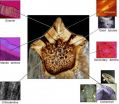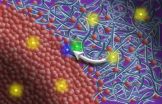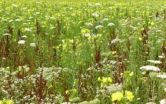(Press-News.org) Herbivorous insects, such as aphids, damage plants and can substantially reduce yields in agricultural settings; however, they can play a major role in maintaining genetic diversity. Ecologists Tobias Züst and Lindsay Turnbull from the University of Zurich together with colleagues from California and Great Britain demonstrated the importance of variation in herbivore communities using the model plant, Arabidopsis thaliana, also known as wall cress. According to Züst, the work is one of the first experimental confirmations of a forty-year-old theory that herbivorous insects exert strong selective pressure on their host plants. Moreover, plants were quick to abandon defense mechanisms when pests were absent, confirming the high costs of these defenses.
Like many other plants, Arabidopsis thaliana, or wall cress, defends itself against pests with a sophisticated chemical arsenal. The pests, however, continually evolve mechanisms to tolerate or metabolize particular chemical components. This means that depending on the abundance of different pest species, different compounds will provide optimal protection, and thus the plant needs to produce a carefully tailored cocktail that will be effective against the most likely attackers. The researchers' first step was to study the distribution of different chemical defenses in natural populations of Arabidopsis thaliana across Europe and compare it to the geographic distribution of two important pest species: the cabbage and the mustard aphid.
Local pest populations as an evolutionary force
The scientists demonstrate that the main chemical compounds produced by Arabidopsis thaliana in South-western Europe differ from those in North-eastern Europe. This pattern correlates directly with a shift in the composition of the aphid communities. In the second step, the researchers studied experimentally whether different aphid species could directly select for these different chemical compounds under controlled conditions. To this end, they exposed mixed populations of Arabidopsis thaliana to the cabbage and mustard aphid populations typical of North-eastern or South-western Europe. After five plant generations, continuous feeding by the different aphid species led to the selection of different chemical profiles, and these were consistent with the patterns seen in nature. "There is natural variation in chemical defenses which is under genetic control", explains Züst "and this variation is maintained by geographic variation in the composition of aphid communities". "Genetic variation is the raw material for evolution", he continues, "so the maintenance of genetic diversity is essential if populations are to respond to future environmental changes such as climate change or environmental degradation".
The costs of defense
In the control populations with no aphid feeding, some of the successful genotypes from aphid populations were lost. According to Turnbull, this occurred because defense mechanisms are costly for the plant and often come at the expense of growth: "Genetic diversity was only maintained across the different treatments; within each treatment much of the diversity was lost. In the control populations, this meant the loss of defended genotypes, as here investment in costly defenses brings no benefit to the plant". Today, the genetic diversity of many plant species is being eroded. For example, agricultural plants are selected for rapid growth and maximum yield at the expense of natural defenses, making the use of pesticides inevitable. In future, the new findings could be used to develop customized seeds that are more resistant to specific local pest communities, thus limiting the use of pesticides.
INFORMATION:
Further reading:
Tobias Züst, Christian Heichinger, Ueli Grossniklaus, Richard Harrington, Daniel J. Kliebenstein, Lindsay Turnbull. Natural enemies drive geographic variation in plant defenses. Science. October 5, 2012, doi: 10.1126/science.1226397.
Contact:
Dr Tobias Züst
Department of Ecology and Evolutionary Biology
Cornell University
Phone +1 607 319 99 05
e-mail: tobias.zuest@cornell.edu
Dr. Lindsay Turnbull
Institute of Evolutionary Biology and Environmental Sciences
University of Zurich
Phone +41 44 635 61 20
e-mail: lindsay.turnbull@ieu.uzh.ch
Plants adapt their defenses to the local pest community
2012-10-05
ELSE PRESS RELEASES FROM THIS DATE:
Duck-bill dinosaurs had plant-pulverizing teeth more advanced than horses
2012-10-05
A team of paleontologists and engineers has found that duck-billed dinosaurs had an amazing capacity to chew tough and abrasive plants with grinding teeth more complex than those of cows, horses, and other well-known modern grazers. Their study, which is published today in the journal Science, is the first to recover material properties from fossilized teeth.
Duck-bill dinosaurs, also known as hadrosaurids, were the dominant plant-eaters in what are now Europe, North America, and Asia during the Late Cretaceous about 85 million years ago. With broad jaws bearing as many ...
Medication use higher among overweight, obese kids
2012-10-05
(Edmonton) Overweight children are far more likely to take prescription medications than children of a normal weight—a trend that adds to already higher health-care costs for treating childhood obesity, according to new research from the University of Alberta.
Researchers from the School of Public Health analyzed the medication use of more than 2,000 Canadian children through the 2007 to 2009 Canadian Health Measures Survey. They found that overweight and obese kids aged 12 to 19 years were 59 per cent more likely than their normal-weight peers to take prescription medication.
Co-author ...
TMT will take discoveries of stars orbiting the Milky Way's monster black hole to the next level
2012-10-05
Researchers have discovered a star that whips around the giant black hole at the center of our galaxy in record time, completing an orbit every 11.5 years. The finding, appearing today in the journal Science, points ahead to groundbreaking experiments involving Einstein's general theory of relativity. Those tests will be fully enabled by the Thirty Meter Telescope (TMT), slated to begin observations next decade.
The record-setting star, called S0-102, was detected with the twin 10-meter telescopes at the W.M. Keck Observatory in Hawaii. For the past 17 years, the telescopes ...
Story tips from the Department of Energy's Oak Ridge National Laboratory, October 2012
2012-10-05
ELECTRICITY-- Spotlight on outages . . .
When a storm knocks out power, among the first questions to be answered are how many people are affected and when electricity will be restored. Oak Ridge National Laboratory's Energy Awareness and Resiliency Standardized Services application, or EARSS, uses publicly available data and can help by showing grid status in real time. The goal is to enhance situational awareness for the emergency response community, according to EARSS co-developer Steve Fernandez of ORNL's Computational Sciences and Engineering Division. "Working from ...
Researchers find ancient carbon resurfacing in lakes
2012-10-05
RICHMOND, Va. (Oct. 4, 2012) – A new study reveals that a significant amount of carbon released into the atmosphere from lakes and rivers in Southern Québec, Canada, is very old – approximately 1,000 to 3,000 years old – challenging the current models of long-term carbon storage in lakes and rivers.
Previous studies have suggested that there is a tight coupling between the terrestrial and aquatic environment such that aquatic bacteria rapidly consume modern carbon. The new findings of the respiration of old carbon in aquatic systems suggests there may be significant lags ...
Northern conifers youngest of the species
2012-10-05
New Haven, Conn.—Dramatic shifts in the planet's climate and geography over millions of years changed the course of evolutionary history for conifer trees, according to a Yale paper in the Proceedings of the National Academy of Sciences.
Yale researchers examined the fossil record and genetic makeup of 489 out of more than 600 living conifer species and discovered that while most conifers belong to ancient lineages, most Northern Hemisphere species, including the majority of pines and spruces, appeared within the past 5 million years.
They argue that the migration ...
Researchers reveal how solvent mixtures affect organic solar cell structure
2012-10-05
Controlling "mixing" between acceptor and donor layers, or domains, in polymer-based solar cells could increase their efficiency, according to a team of researchers that included physicists from North Carolina State University. Their findings shed light on the inner workings of these solar cells, and could lead to further improvements in efficiency.
Polymer-based solar cells consist of two domains, known as the acceptor and the donor layers. Excitons, the energy particles created by solar cells, must be able to travel quickly to the interface of the donor and acceptor ...
Improving confidence keeps breast cancer survivors exercising
2012-10-05
CORVALLIS, Ore. – More than 40 percent of older breast cancer survivors are insufficiently active after leaving a supervised program. But new research shows that those women who developed behavioral skills such as self-confidence and motivation during their program were far more likely to continue exercising on their own.
Regular exercise may reduce the risk of breast cancer recurrence and breast cancer-related mortality, experts say, making it crucial to effectively target breast cancer survivors who do not engage in regular physical activity for interventions.
Researchers ...
Why we need insects -- even 'pesky' ones
2012-10-05
At first blush, many people would probably love to get rid of insects, such as pesky mosquitoes, ants and roaches. But a new study indicates that getting rid of insects could trigger some unwelcome ecological consequences, such as the rapid loss of desired traits in plants, including their good taste and high yields.
Specifically, the study--described in the Oct. 5, 2012 issue of Science and funded by the National Science Foundation showed that evening primroses grown in insecticide-treated plots quickly lost, through evolution, defensive traits that helped protect them ...
MU researcher identifies factors to help parents and professionals recognize teens in distress
2012-10-05
Suicide is the third-leading cause of death for teens, according to the Centers for Disease Control and Prevention. Now, a University of Missouri public health expert has identified factors that will help parents, medical professionals and educators recognize teens at risk for self injury and suicide.
"For many young people, suicide represents an escape from unbearable situations—problems that seem impossible to solve or negative emotions that feel overwhelming," said Lindsay Taliaferro, an assistant professor of health sciences at MU. "Adults can help these teens dissect ...






